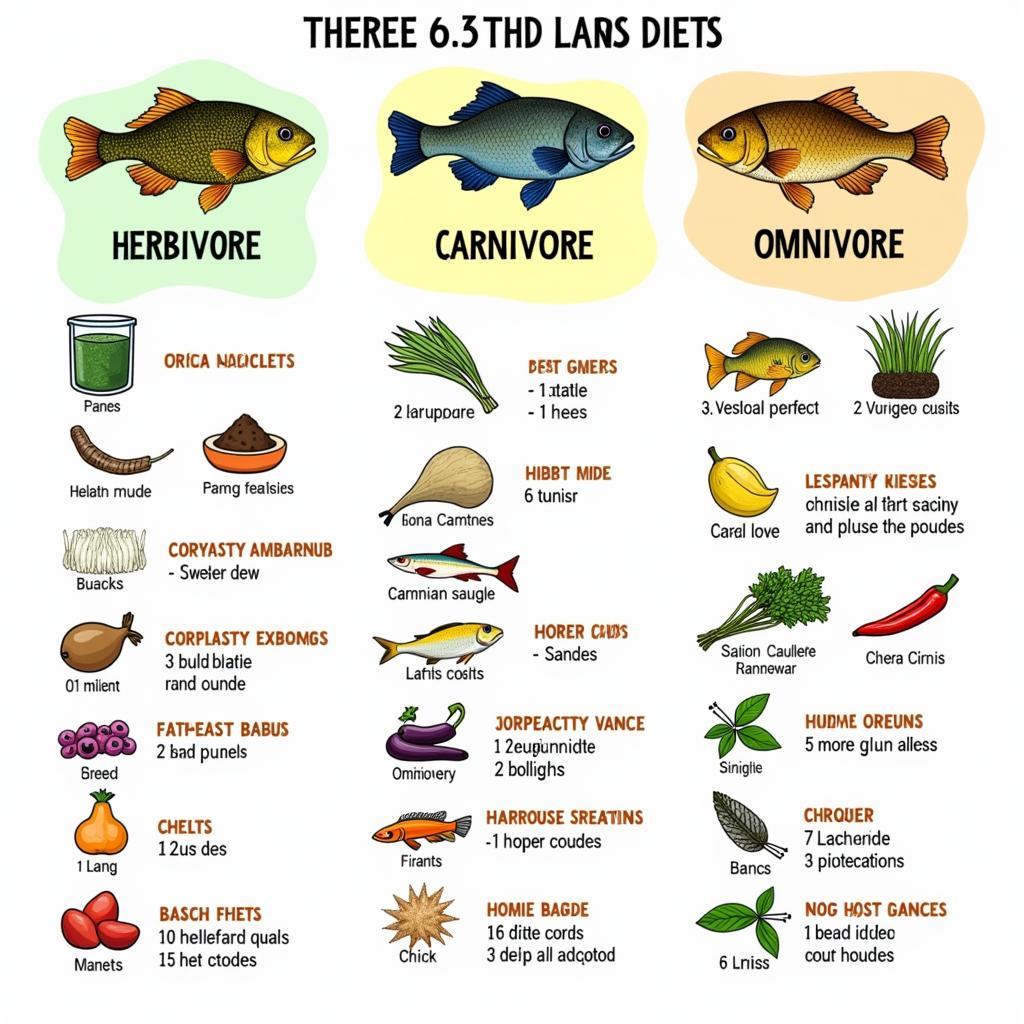Choosing the right cichlid fish food is crucial for their health, growth, and vibrancy. With so many options available, it can be overwhelming to know what your cichlids need. This comprehensive guide will navigate you through the world of cichlid nutrition, ensuring you’re providing your aquatic companions with the best possible diet.
Understanding Cichlid Dietary Needs
Cichlids are a diverse group with varying dietary requirements. Some are primarily herbivores, grazing on algae and plant matter, while others are carnivores, relishing insects, crustaceans, and even smaller fish. And then there are the omnivores, enjoying a mix of both worlds.
 Types of Cichlid Diets
Types of Cichlid Diets
Identifying your cichlid’s dietary category is paramount before selecting their food. Researching the specific species you own is essential to understand their natural feeding habits and replicate them in the aquarium.
Types of Cichlid Fish Food
A wide range of cichlid fish food caters to their diverse needs. Let’s dive into the most popular options:
Flakes: A Staple Choice
Flakes are a common choice for cichlids, especially for those who readily accept food from the water’s surface. They offer a good balance of nutrients and are available in various formulas targeting different cichlid types, such as tropical fish food pellets. However, flakes can quickly dirty the tank if not consumed promptly.
Pellets: Sinking vs. Floating
Pellets offer a more controlled feeding experience. They come in sinking and floating varieties, catering to cichlids that prefer to feed at different water levels. For instance, best food for mbuna cichlids often consists of sinking pellets, mimicking their natural bottom-feeding behavior.
Frozen Foods: A Nutrient Boost
Frozen foods like bloodworms, brine shrimp, and mysis shrimp are excellent sources of protein and essential nutrients. They mimic the live prey cichlids would consume in the wild, promoting vibrant coloration and robust growth. You can find high-quality frozen cichlid food at most reputable aquarium stores.
Live Foods: Encouraging Natural Instincts
Live foods like feeder fish and insects can be offered sparingly to stimulate your cichlids’ natural hunting instincts. However, it’s crucial to ensure the feeder fish are disease-free and appropriately sized to prevent harm to your cichlids.
Vegetables: For the Herbivores
Herbivorous cichlids thrive on a diet rich in plant matter. Blanched spinach, zucchini, and peas are excellent choices. You can also find commercially prepared algae wafers specifically designed for herbivorous fish.
 Variety of Cichlid Food
Variety of Cichlid Food
Choosing the Right Cichlid Fish Food
With so many choices, selecting the right cichlid fish food can seem daunting. Here’s a simple guide to help you:
- Consider Your Cichlid’s Diet: Are they herbivores, carnivores, or omnivores?
- Read the Label: Look for high-quality ingredients and a good balance of protein, fat, and fiber.
- Variety is Key: Offer a varied diet to ensure your cichlids receive a wide range of nutrients.
- Fresh is Best: While prepared foods are convenient, supplementing with fresh foods like vegetables can enhance their diet.
- Observe Your Fish: Monitor your cichlids’ health and adjust their diet accordingly.
How Much and How Often to Feed Your Cichlids
Overfeeding is a common mistake that can lead to water quality issues. As a general rule, feed your cichlids only what they can consume in 2-3 minutes, twice a day.
Cichlid Fish Food: Ensuring Optimal Health
“Providing a balanced and nutritious diet is fundamental to the well-being of your cichlids,” says renowned aquarist, Dr. Sarah Miller. “By understanding their dietary needs and offering a variety of high-quality foods, you can ensure they thrive in your care.”
FAQs about Cichlid Fish Food
1. Can I feed my cichlids human food?
While some human foods like blanched vegetables are safe, it’s best to stick to commercially prepared cichlid fish food to ensure a balanced diet.
2. How do I know if my cichlids are getting enough food?
Observe their behavior. If they are actively searching for food after feeding, you may need to increase the amount.
3. Can I mix different types of cichlid food?
Yes, offering a variety is beneficial. You can mix flakes, pellets, and frozen foods for a more diverse diet.
4. What are some signs of malnutrition in cichlids?
Loss of appetite, faded coloration, lethargy, and unusual swimming patterns can indicate malnutrition.
5. What is the best omega fish food for cichlids?
Omega-rich foods like krill and mysis shrimp are excellent for promoting vibrant coloration and overall health.
6. Where can I find reputable brands of mazuri fish food?
Reputable aquarium stores often carry high-quality brands like Mazuri, known for their specialized fish food formulas.
7. How long can cichlids go without food?
Healthy adult cichlids can typically go for a week without food, but it’s best not to leave them unfed for extended periods.
Need More Help?
Choosing the right cichlid fish food is an important step in responsible fishkeeping. By understanding your cichlids’ dietary needs and providing them with a varied and nutritious diet, you can ensure they live long, healthy, and vibrant lives.
For personalized advice and support, contact us at Mina Cones Food. Our team of experts is available 24/7 to assist you with all your cichlid care needs. Reach us at Phone Number: 02437655121, Email: minacones@gmail.com or visit us at 3PGH+8R9, ĐT70A, thôn Trung, Bắc Từ Liêm, Hà Nội, Việt Nam. We are here to help!